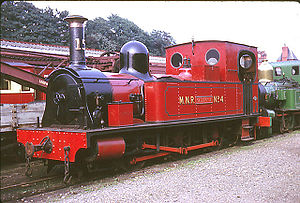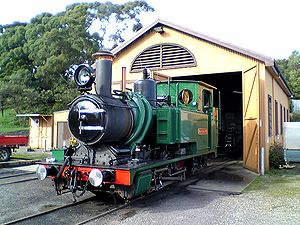- Dübs and Company
-
Dübs & Co. was a locomotive works in Glasgow, Scotland, founded by Henry Dübs in 1863 and based at the Queens Park Works in Polmadie. In 1903 it became part of the North British Locomotive Company.
Contents
Preserved locomotives
 NSB locomotive class XXI number 1 photographed at Dübs & Co. Locomotive Works before delivery to Setesdalsbanen. Photograph by Dübs & Co., 1894.
NSB locomotive class XXI number 1 photographed at Dübs & Co. Locomotive Works before delivery to Setesdalsbanen. Photograph by Dübs & Co., 1894.
 NSB locomotive class XXI number 1 photographed at Kristiansand station in August, 1938. Photograph by Jim Jarvis. Note the spark arresting chimney, the electric lighting, the air brake reservoir and the injector.
NSB locomotive class XXI number 1 photographed at Kristiansand station in August, 1938. Photograph by Jim Jarvis. Note the spark arresting chimney, the electric lighting, the air brake reservoir and the injector.
Locomotives built by Dübs & Co. are still in existence today. Eleven of these are locomotives built for the New Zealand Railways Department but numerous others are extant in South Africa and the Isle of Man.
Preserved locomotives in New Zealand
Four members of the 0-4-0 A class built in 1873 have been preserved. A 64 and A 67 are in full operational condition on vintage railways in New Zealand; A 62 is in private ownership and it is understood that the smokebox has been snapped from the boiler, and A 66 was damaged by fire when the building in which it was kept on static display was burnt down, but its current owners intend to restore it back to an operational condition.
Two members of the C class have survived and both are Dübs engines even though only five of the sixteen C class locomotives were built by Dübs & Co. Currently in operation at the Silver Stream Railway is an example from 1875 that originally had the wheel arrangement of 0-4-0 but was converted soon after purchase to 0-4-2 and is preserved with that wheel arrangement. Another member of the C class was recovered by the Westport Railway Preservation Society in 1993 from where it had been dumped in the Buller Gorge, West Coast, and it is currently under restoration with the ultimate goal of returning it to a fully operational state.
Five members of the 0-6-0 F class built between 1878 and 1880 have been preserved. Currently in operational condition are F 163 and F 185. F 111 had its boiler condemned in 1980 and its owners, the Ocean Beach Railway, are yet to replace it; the Ocean Beach Railway also owns F 150 but it has been on lease to the Plains Vintage Railway of Ashburton since 1986 and is currently unrestored and partially dismantled. F 230 was converted to a wheel arrangement of 0-4-2 during its time working on a private industrial line and is currently on static display at Hamilton Lake Park in a somewhat rundown condition. Other members of the 88-total F class still exist, but they were built by other manufacturers, though some records state F 233 was also built by Dübs & Co.
Preserved locomotives elsewhere
 Isle of Man Railway locomotive no. 15 Caledonia originally built in 1885 for the Manx Northern Railway as no. 4. Seen here at Douglas station in 1969 in MNR colours
Isle of Man Railway locomotive no. 15 Caledonia originally built in 1885 for the Manx Northern Railway as no. 4. Seen here at Douglas station in 1969 in MNR colours
In the United Kingdom, 1901-built Dübs crane tank No. 4101 is preserved at the Foxfield Light Railway, Stoke-on-Trent. As of June 2008, it is currently undergoing a major overhaul.
A single example of a Dübs locomotive can be seen on the Isle of Man Railway. An 0-6-0, it was originally built as no. 4, Caledonia in 1885 (works no. 2178) for the Manx Northern Railway. It was renumbered 15 when brought into IoMR stock in 1904 (Boyd 1996; p. 188-192).
Two steam locomotives built in 1894, locomotives number 1 and 2 of NSB class XXI, are still preserved at the Setesdalsbanen museum railway, Norway. Number 1 has been out of service since the closure of ordinary activities at Setesdalsbanen in 1962. Number 2 has been in regular use at Setesdalsbanen since 1894 and until recently, both during ordinary activities and, since 1964, at the museum railway. It is currently undergoing a general service (as of August, 2005).
One steam locomotive built for the Canadian Pacific Railway in 1882 is currently owned by the Prairie Dog Central enthusiast railway of Winnipeg, Manitoba. The locomotive has just undergone a thorough restoration, which was completed in early 2009.
One steam locomotive built for the Emu Bay Railway in Tasmania, Australia in 1900. It is currently preserved at the Don River Railway preservation society in Devonport, Tasmania.
 West Coast Wilderness Railway locomotive no. 3730 originally built in 1898. Seen here leaving the shed at Strahan, Tasmania in September 2009
West Coast Wilderness Railway locomotive no. 3730 originally built in 1898. Seen here leaving the shed at Strahan, Tasmania in September 2009
One steam locomotive built in 1898 (No 3730) is currently used for the West Coast Wilderness Railway between Strahan, Tasmania and Queenstown, Tasmania, Australia. This unit was locally fitted for the Abt Rack railway system.[1]
Another preserved loco that was originally built in 1882 for Natal Government Railways (NGR), a predecessor to South African Railways, is a Dubs Class-A NGR No.88 that has been restored and preserved by Umgeni Steam Railway (Durban, South Africa). It is an example of the loco used on the short (3.2 km (2 mile)) route from Durban to Point Road and later on the 23-hour trip from Durban to Johannesburg.
Built in 1888 for former Brazilian CP (unknown numbering) and later having been an industrial locomotive at Frigorífico Bordon, there is Dubs #2351, a 2-6-4T for 5 ft 3 in (1,600 mm) gauge which has been completely restored for static exhibition at Museu de Tecnologia de São Paulo (São Paulo Technology Museum in São Paulo, SP.
See also
- Category:Dübs locomotives
References
- ^ "West Coast Wilderness Railway Tasmania". Tom Worthington. http://www.tomw.net.au/blog/2009/09/west-coast-wilderness-railway-tasmania.html. Retrieved 2009-09-26.
- Anon. (1951) "The North British Locomotive Co. Ltd", Railway Magazine, 97, Part 1, p. 3–8; and Part 2, p. 82–90 & 92–93
- Boyd, J.I.C., (1996), The Isle of Man Railway: Volume 3, An Outline History of the Isle of Man Railway including the Manx Northern Railway and The Foxdale Railway, The Oakwood Press, ISBN 0-85361-479-2
- Durrant, A.E. (1989) Twilight of South African Steam, David & Charles, ISBN 0-7153-8638-7
- Heath, Eric, and Stott, Bob (1993) Classic Steam Locomotives Of New Zealand, Vol. 1, Grantham House, ISBN 1-86934-036-1
External links
- Information from the Weka Pass Railway on the preserved members of the original A class built by Dübs & Co.:
- Information from the Weka Pass Railway on the preserved members of the F class built by Dübs & Co.:
- Silver Stream Railway's preserved locomotives page - includes a section on the preserved member of the C class
- Umgeni Steam Railway - steam railway preservation group, Durban, South Africa: [1]
Categories:- Locomotive manufacturers of the United Kingdom
- Manufacturing companies of Scotland
- Defunct companies of Scotland
- Companies based in Glasgow
Wikimedia Foundation. 2010.


